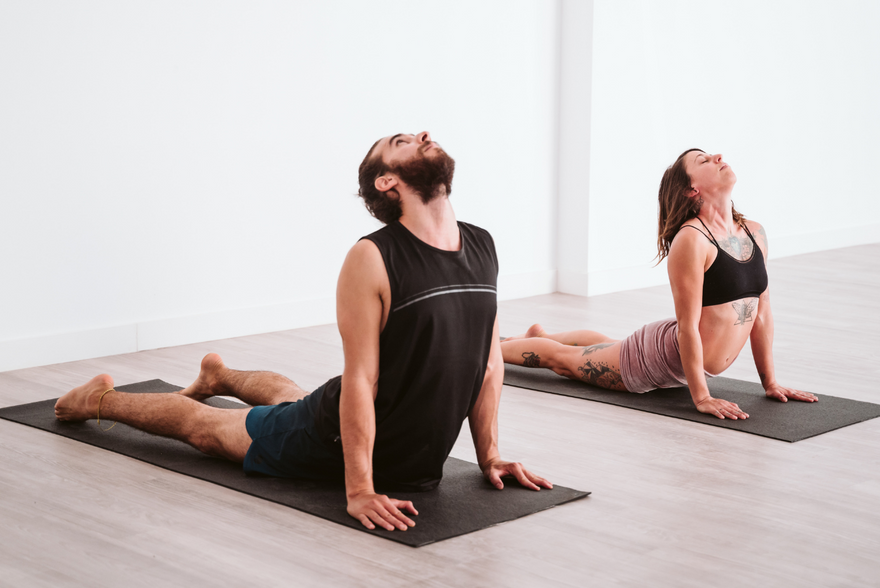The name suggests it: Power Yoga is a physical style of yoga that will definitely make you sweat. If you are looking for a physical challenge and want to benefit from the benefits of yoga at the same time, Power Yoga is the right choice for you.
Power yoga exercises aim to find your own limits and go beyond them. The aim is not only to find physical strength, but also inner “power”.
Breathing exercises and meditation play no role in this style of yoga - this is why Power Yoga has had a major influence on the popularity of yoga in the Western world. The yoga style gave people access to yoga practice, initially without having to deal with the spiritual background.
Not all Power Yoga is the same: the term is not protected and is often used for various physically demanding yoga courses. For example, Core Power Yoga, which you can find in many fitness studios, is popular.
If you are looking for the “original”, it is worth asking first. This comes from the USA and is a modified form of Ashtanga Yoga by Bryan Kest. Incidentally, Kest was himself a student of Pattabhi Jois, who is considered the inventor of Ashtanga Yoga.
Power yoga in focus: how does it work?
Power yoga focuses on physical exercises. This is the biggest difference to “classic” yoga – if that even exists. What's more: you won't find breathing exercises and meditation in Power Yoga. Breathing still plays a role, because the Power Yoga exercises are also practiced in harmony with breathing.
Unlike, for example, Core Power Yoga, which focuses on strengthening the abdominal muscles and back and is also suitable for losing weight, this was not Bryan Kest's primary intention. However, it is definitely a side effect of regular practice.
The goal of Power Yoga is to find yourself through your body and challenging exercises, to become calmer and more relaxed and to get more energy. Power Yoga is not that different from other styles of yoga - the path is just different.
This is how power yoga exercises work:
- Strength, endurance and mobility improve
- trains coordination and concentration
- Muscles are strengthened and the body is toned
- promotes calm and serenity by focusing on movement in harmony with breathing
Power Yoga: Who is Power Yoga suitable for?
Anyone who is looking for a body-focused yoga style and wants to train the body intensively is in good hands with Power Yoga. Be prepared to sweat and be ready to step out of your comfort zone.
If you are not currently (yet) interested in topics such as breathing exercises, meditation or spirituality, but still want to find an approach to yoga, Power Yoga is also great. Power Yoga offers an easy way into yoga practice so that you can later try out other styles of yoga - whenever you're ready.
Is Power Yoga also suitable for beginners?
Power Yoga does not require any experience in other yoga styles, so Power Yoga is also suitable for beginners. A certain level of basic physical fitness is an advantage, as Power Yoga will definitely challenge you physically. For example, if you regularly train in the gym or do other sports, there is nothing wrong with a yoga class.
If you are unsure whether Power Yoga is the right yoga style for you as a beginner, you will find tips for getting started and an overview of suitable yoga styles for beginners in our article Yoga for Beginners.
You can also do power yoga exercises at home. Here is an overview of the most important Power Yoga exercises and the typical course of a Power Yoga class.

Power Yoga: Exercises and sequence of a yoga class
For power yoga you don't need any special equipment other than a yoga mat. You're well equipped with comfortable, sweat-absorbing yoga clothing like our yoga leggings for women and a matching yoga top .
The exercises consist of various Vinyasa flows - dynamic sequences of different positions in which breathing and movement are synchronized. That means one breath per movement. Some of the exercises will probably look familiar to you if you have already tried other styles of yoga. Unlike Ashtanga Yoga, the sequences of Vinyasa flows are not precisely defined and always the same, but can be individually determined and adapted by the teacher.
With an average of 45 minutes, a Power Yoga class is shorter than other yoga classes. Which is absolutely sufficient due to the intensity. The lesson consists of three parts:
- Warm up
- Bulk
- Cool down
Power yoga exercises: warm-up
In power yoga, the sun salutation is usually used to warm up the entire body. You can find instructions for sun salutations and many other asanas in our article on the most popular yoga exercises .
Power Yoga exercises: The main part
The main part consists of different Vinyasa flows that are determined by the teacher. Everyone can practice at their own pace and adapt the difficulty to their own level if necessary.
Popular exercises in the main part:
- Triangle (Trikonasana)
- Plank (Phalakasana)
- Yoga push-ups (Chaturanga Dandasana)
- standing forward bend (Uttanasana)
- Warrior Variations (Virabhadrasana I - III)
- Sideways Twisted Angle (Parivrtta Parsvakonasana)




Power yoga exercises: cool down
Every Power Yoga class ends with a cool down and a short relaxation sequence.
Power yoga is a great way to give your body an intense workout. But it's more than just a fitness workout: the demanding exercises in harmony with breathing allow you to find access to yourself and your body and to become calm and serene inside. Power Yoga is a great way to get started with yoga practice if you are not (yet) concerned with the spiritual background of yoga but still want to find an approach.
